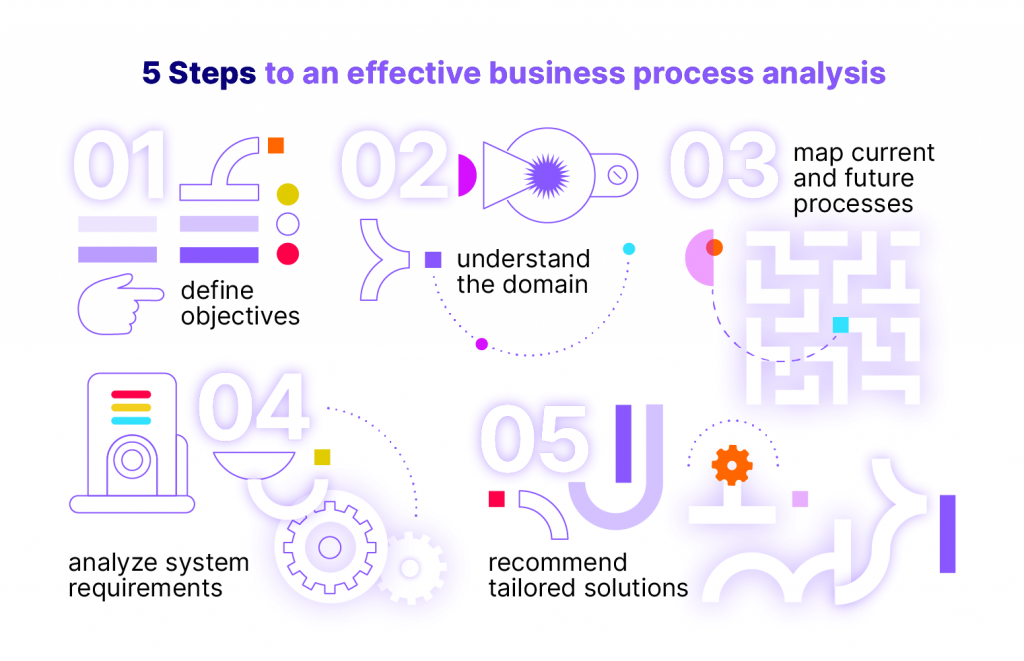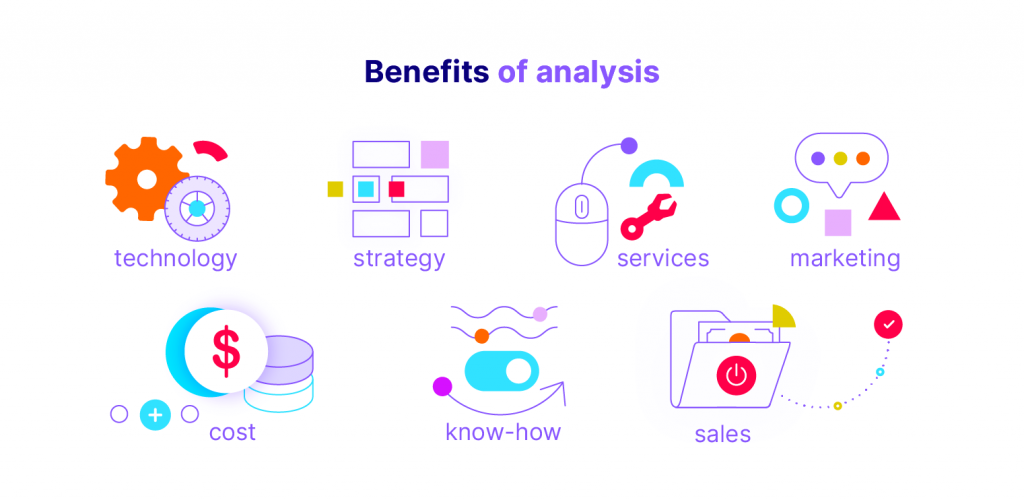Why process analysis is the foundation of successful business automation?
- 05.05.2025
- 9 min
Business process automation is a key element of digital transformation. However, implementing technology alone does not guarantee success — the crucial first step is a thorough analysis of the processes to be automated. Companies that skip this phase often face challenges such as low automation efficiency, poor return on investment (ROI), or the need for costly corrections.
In this article you will find:
- How does analysis impact the implementation of business automation?
- How to conduct an effective analysis?
- Execution Approach – A Proven Method for Process Analysis
- Benefits of Business Analysis
- Business-System Analysis for Launching a New Business Line for Alior Leasing
- Investment in Analysis as a Key Step to Automation Success
Did you know that according to Bain & Company, while over one-third of large organizations undergo business transformation within a given timeframe, only about 12% actually achieve their initial goals and ambitions? More and more companies are investing in modern technologies — yet many overlook a critical step: process analysis. Without it, automation implementation can lead to confusion, inefficiency, and frustration. So how can you avoid common pitfalls and ensure your organization gains the full value from automation?
How does analysis impact the implementation of business automation?
Before diving into specific aspects of the analysis process, it’s worth emphasizing its overall importance. A solid analysis is not just about understanding existing processes — it's about building a strong foundation for effective automation. Business Process Analysis (BPA) involves a detailed examination of a company’s operations to identify strengths, areas for improvement, and opportunities for optimization. It results in concrete deliverables, such as functional and non-functional requirements, a project backlog, and a solution architecture.
Thanks to this stage, an organization — for example, a financial institution — ensures a smooth and predictable implementation of new systems. Analysis also helps identify potential improvements and reduce risks. Without it, a company might invest in expensive technologies that fail to deliver the expected results. Only after a thorough evaluation can you make informed decisions about which business areas are worth automating and how to do it effectively.
How to conduct an effective analysis?
An effective analysis is a structured process that helps a company move from an idea to real change — driven by data, business needs, and the right-fit technology. It’s not just a preparatory phase, but a critical foundation for any automation project. So how do you approach it step by step?
- Define Objectives
In every dynamic organization, numerous ideas emerge — but not all align with the company’s strategy or stakeholder expectations. That’s why a proper analysis should begin with clarifying the business vision and objectives. This step ensures that any planned changes are strategically meaningful and will genuinely support the organization’s growth.
- Understand the Domain
The next step involves business workshops. This is when we gather key domain events and processes — we learn how things truly work in practice. It allows us to design solutions that are rooted in the company’s operational reality. Our experience in the leasing and finance sector enriches this process with proven practices and domain-specific insights.
- Map Current and Future Processes
We document the current state of business processes (AS-IS) to fully understand their flow, dependencies, and bottlenecks. Then, we design the future state (TO-BE), which illustrates how processes should function after automation is implemented. Comparing both states helps identify specific areas for improvement and align technology accordingly.
- Analyse System Requirements
At this stage, we define both functional and non-functional requirements — they form the foundation of the project backlog. We identify which systems need to be modified and which will need to integrate with the new solutions. This approach significantly reduces the risk of costly mistakes during implementation.
- Recommend Tailored Solutions
The outcome of the analysis is not just documentation but a clear architectural map — including system recommendations, integration guidelines, and an implementation plan. We create a flexible and scalable IT architecture that’s ready for future development and changes.

Execution Approach – A Proven Method for Process Analysis
We conduct the analysis in a structured, transparent, and business-oriented manner tailored to each client’s reality. At the beginning of the project, we prepare a detailed plan for the analytical workshops — defining the goals of each session and identifying the teams that should be involved. This ensures that the right people are engaged from the start, building a shared understanding of the project’s scope and objectives.
We work at a pace aligned with the intensity of the tasks — typically conducting one or two workshops per day, each lasting no more than four hours. This model allows us to thoroughly analyze the processes and ask the right questions, while giving the client time and space to reflect and make well-informed decisions.
We tailor our working mode to the client’s preferences – workshops can be conducted remotely or in a hybrid format. All materials are shared online, and if there are any access issues, they are delivered directly after each session. We ensure smooth collaboration and a fast flow of information.
Throughout the analysis process, we stay agile and adaptable – we know when it's worth “parking” a topic and when to revisit it at the right time. Our team prioritizes transparency and partnership – we work hand-in-hand with the client as one unified team, focused on finding the best possible solution.
Outcomes – Tangible Results and Practical Tools
The outcome of the analysis includes concrete deliverables that serve as a solid foundation for the next stages of the project. Business process flows are documented and presented using proven tools such as Miro, bpmn.io, Figma, draw.io, PlantUML, or Enterprise Architect. This ensures a clear and structured visualization of key insights, making it easy to discuss and validate them with project teams.
As part of our work, we also prepare detailed documentation of both functional and non-functional requirements. These deliverables are provided in formats tailored to the client’s preferences – such as Excel spreadsheets, Word documents, or entries in Confluence. All materials are designed to be directly applicable in implementation projects or RFP (Request for Proposal) processes.
Importantly, we validate key findings during the workshops, and full final approval takes place within a maximum of three business days after the analysis is complete. Our goal is not only to perform business process analysis, but above all to deliver ready-to-use, practical outcomes that truly accelerate the next stages of transformation.
Benefits of Business Analysis
Although the implementation of automation technologies requires careful planning and detailed analysis, the benefits of this process are truly significant. Through automation, organizations can gain a competitive edge, introduce flexibility in their operations, and better align their services with market needs. However, it's important to remember that success in automation doesn't solely depend on technology, but also on the right approach to planning, implementation, and monitoring of processes.
- The Success of an Automation Project Depends on Addressing Key Business Factors
For the successful implementation of automation, it is crucial to consider the business needs and strategic objectives of the organization. Only then can automation be properly planned to align with the company’s requirements and deliver the expected results.
- Automation Shouldn't Be an "All-or-Nothing" Approach
Automation does not have to encompass the entire process at once. A more effective approach is gradual implementation, which allows for adapting technology to changing conditions and assessing outcomes at each stage.
- Thanks to Automation, Businesses Can Offer More Choices to Their Customers
Automation enables companies to adapt their offerings more quickly and flexibly to meet customer needs, which can positively impact user experiences and enhance the company's competitiveness in the market.
- Automation Is One of the Best Ways to Achieve Scalability
With automated processes, companies can expand their operations more easily without having to proportionally increase human resources. Scalability is a crucial element in organizational growth, especially in the context of increasing demand for products or services.
- Automation Projects Are Not Implemented All at Once; They Are Carried Out in "Increments"
Automation is a process that should be executed in several stages, starting with the identification of the most demanding areas and ending with the full implementation of the technology. This model allows for continuous optimization of solutions and minimizes the risk of errors.Korzyści płynące z procesu analizy
For example, in the case of an automation implementation in a financial institution, process analysis provides tangible, measurable benefits.
• Technology – creating an integrated technological environment tailored to the scale of operations, enabling efficient handling of automation processes.
• Strategy – precisely defining user needs and motivations, considering the strategic directions for service development.
• Cost – accurately estimating implementation costs and prioritizing project stages, ensuring optimal budget management.
• Know-how – developing a model and methodology that can be utilized in future automation projects.
• Sales – strengthening sales processes through automation, leading to greater efficiency and reduced demand for manual interventions.
• Marketing – developing a technological support strategy for marketing activities, leading to better customer segmentation and more effective campaigns.

Business-System Analysis for Launching a New Business Line for Alior Leasing
Our experience in conducting business-system analysis is exemplified by a project completed for Alior Leasing, where we supported the client in launching a new business line. The goal of the analysis was to align the company’s offering with changing market conditions and establish a solid foundation for the implementation of solutions related to vehicle financing, a marketplace platform, and a self-service platform for clients.
As part of the project, we conducted 15 workshops involving key stakeholders and business teams, mapping out one sales process and five supporting processes. The outcome of the analysis was the definition of 149 functional and non-functional requirements, which were used to create system recommendations and a flexible IT architecture.
The entire process – from identifying objectives, through modeling AS-IS and TO-BE processes, to providing solution recommendations – was carried out with an agile collaboration mindset, focused on achieving real business results.
Investment in Analysis as a Key Step to Automation Success
Investing in process analysis before implementing automation is the key to success. Companies that dedicate time and resources to thorough analysis and process optimization can expect significantly greater benefits, both financial and operational. It's important to remember that the success of automation is not just about introducing new technologies, but also about the ability to tailor them to the real needs and business objectives of the organization.
Have an automation idea but don't know where to start? We can help you organize your goals, conduct an analysis, and choose the best solutions. Get in touch with us and start taking informed action today.